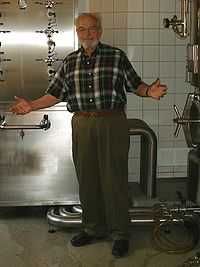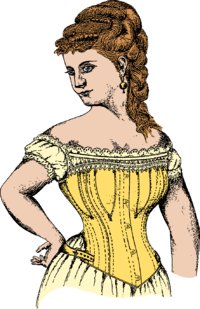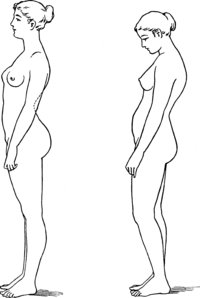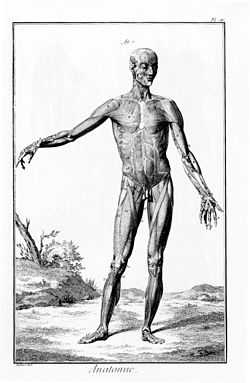Posture (psychology)
_-_WGA16521.jpg)
In humans, posture can provide a significant amount of important information on nonverbal communication and emotional cues. Psychological studies have shown the effects of body posture on emotions. This research can be traced back to Charles Darwin when he studied emotion and movement in humans and animals.[1] Currently, many studies have shown that certain patterns of body movements are indicative of specific emotions.[2][3] Researchers studied sign language and found that even non-sign language users can determine emotions from only hand movements.[4] Another example is the fact that anger is characterized by forward whole body movement.[5] The theories that guide research in this field are the self-validation or perception theory and the embodied emotion theory.[5][6][7]
- Self-Validation theory is when a participant's posture has a significant affect on his or her self-evaluation of their emotions. An example of this is an experiment where participants had to think and then write positive qualities of themselves in a confident or doubtful posture.[6] Participants then had to self-evaluate on how good of a job candidate, interviewee, performer, and how satisfied they would be as an employee. Mood and confidence level were also measured. Results from this study proved in favor of the self-validation theory. Participants' attitudes in the confident but not doubtful posture, significantly affected their self-reported attitudes. A similar study showed that participants who were placed in a hunched posture reported were more likely to feel stressed compared to participants who assumed a relaxed position.[7]
- Embodied Emotion theory is the idea that mental events can be represented by states of the body.[5] In a study showing embodied emotion, participants were primed with concepts of pride and disappointment by a word generation task. Researchers hypothesized there would be an observable change in participants' posture based on the word they were primed with. This hypothesis was confirmed for the disappointment prime because participants were more likely to decrease in their vertical height or show slumping behavior.[5]
Common methods
Physical posture and emotion have been studied using two similar techniques. The first method involves the participant viewing videotaped actors performing certain actions and the second method involves having the participant sit in a certain posture and then self-reporting their emotions. In the first method, actors portray and record certain body movements. Participants must view the video and decipher the emotion they believe is being portrayed.[8] In the second method, participants are told to assume a certain body posture and then must complete a survey on their current affective state.[7] Other methods include using neuroscience techniques, such as fMRI's to determine how posture and emotions expressions can affect brain imaging.[9] Another method that is growing in use involves using dancers as 'actors' and having participants observe and determine the emotion the dancer is conveying.[10]
Communication expressed posture
In humans, one of the means of communication is the posture of the body, in addition to facial expressions, personal distances, gestures and body movements.[11] Posture conveys information about:
- Interpersonal relations
- Personality traits such as confidence, submissiveness, and openness.
- Social standing
- Current emotional states
- Characteristics of temperament according to the theory of Hippocrates, Kretschmer, and Sheldon.
Analysis of posture

Posture can signal both the enduring characteristics of a person (character, temperament, etc.), and his or her current emotions and attitudes. Therefore, posture can be considered in the context of a given situation, and independently of it.
Changing factors and posture
Posture as information about the current state of a person's emotions and attitudes should be analyzed in the context of other messages, both verbal and nonverbal as well as that person's cultural and social norms.
Open and closed body posture

- Closed posture is a posture in which parts of the body most susceptible to trauma are obscured. These body parts are: throat, abdomen and genitals. Damage to the genitals prevents the transfer of their genes to future generations and is sometimes seen as being synonymous with death.[12] Therefore, both humans and animals try to protect these vulnerable body parts from injury. In humans, certain behaviors may signal closed posture: Arms crossed on the chest or abdomen, hands clasped in front of the genitals, and crossing legs. Clothing may also signal closed posture: a buttoned suit, or a handbag or briefcase held in front of the person. Closed posture often gives the impression of detachment, disinterest, and hostility. Research has also shown that these behaviors usually convey unpleasant feelings.[4] These feelings were evident when the participant had to observe the closed posture and when he or she was told to assume the posture.
- Open posture is a posture in which the vulnerable parts of the body are exposed. The head is raised, the shirt may be unbuttoned at the neck, a bag is held on the shoulder or at the side. Open posture is often perceived as communicating a friendly and positive attitude. In an open posture the feet are spread and the head is straight. The palms are up and the hands and fingers are spread.[4] Due to this friendly demeanor, research suggests that participants view counselors who use an open posture as more capable of providing guidance.[13]
An important element of closed or open posture of the body are the hands. Showing the palms of the hands can be a signal of open posture, especially if the hand is relaxed. Showing the back of the hand or clenching hands into fists may represent a closed posture. Hands clasped behind the back may also signal closed posture even though the front is exposed because it can give the impression of hiding something or resistance to closer contact.
Closed and open posture also apply when seated. Crossed legs and arms can signal closed posture. As stated before, leaning forward or showing the palms of the hands can signal open posture.
Interpersonal attitudes
Interpersonal attitudes are communicated through:
- Inclination of the body. During conversation, a person may lean slightly toward another person or tilt slightly away from him/her. This behavior is usually unconscious. An inclination towards can be an expression of sympathy and acceptance. Inclining away can signal dislike, disapproval, or a desire to end the conversation. Different inclinations of the head may carry similar meanings.
- Similarity. During the conversation, people have an unconscious tendency to imitate others' behavior. This happens when the conversation runs seamlessly and is enjoyable for both parties. This approximation of attitudes, gestures, and body movements can indicate the emergence of a bond and sympathy and is known as stereotyped behavior as defined by Edwin Ray Guthrie.[14] Lack of synchronous behavior may lead to a sense that the contact is artificial, forced, or unpleasant.
- Orientation of the body. Usually people talk directed toward each other, but not squarely face to face, which can be indicative of a confrontational stance. In conversation, the participants' bodies are usually turned toward each other at an angle. When a person ignores someone else, they tend to ignore or avoid contact by showing the other person their side or back.
- Closed or Open posture.

Posture communicating social standing
Posture can signal an individual's position in social hierarchy.

- If two people of different social standings talk to each other, the person with a higher position usually takes a more relaxed attitude. Their posture may be unbalanced, relaxed, and may appear to be nonchalant. A person with a lower position often maintains symmetrical posture by placing both hands on their lap or at their sides.
- Typically, a person with higher status sits down and talks while sitting. A person of lower status may stand or they may remain standing until they are asked to sit.
Wellbeing
Mood influences muscle tone, energy level, and one's internal sense of well-being. Thus, body posture can reveal a person's current state of mind. Anger, sadness, and disgust are by far the most recognized body postures that are indicative of emotions.[15]
- Stress can affect posture subconsciously; a person under stress will often have a greater amount of muscle tension, and may also have shallow, clavicular breathing.
- Well-being affects posture by giving it a sense of energy and balance. A person's spine will be straight and the head raised.
- Malaise affects posture with a sense of tiredness. A person's shoulders may droop, and the head may be bowed down or tilted to the left or right.
- Confidence affects posture by the uprightness (or not) of one's body.[5][7]
Popular literature has come to interpret postures according to the assumptions of psychoanalysis, thinking that actions such as cross arms over the breasts or crossing legs would be a symptom of a sexual complex.[16] These beliefs, however, have very limited support in systematic research and experimentation. It is more likely that this type of behavior reflects a certain style of self-presentation,[17] rather than unconscious conflicts and complexes.
Stable factors and posture
The term posture is also used to refer to the appearance of the body. In psychology, there are several concepts involving the appearance of the permanent characteristics of individuals. Some habitual positions may also reflect stable characteristics of an individual.
Nature

Wilhelm Reich, a student of Freud, first drew attention to the relationship between shallow breathing, blocked traffic, the difficulty in experiencing sexual pleasure, and emotional disorders, especially neuroses. This concept was developed by Alexander Lowen, founder of bioenergetics. He is also author of the concept of muscular block. Lowen noted that when people do not want to experience certain emotions, they tighten certain muscles.[18] For example, when someone does not want to cry, they can tighten the jaws, which suppresses tears. Stress and anger tighten the muscles along the spine and thighs, which can manifest itself in pain in those body parts, if the stress was prolonged. According to Lowen, some tensions become chronic: the muscular block always activated, regardless of the circumstances. This is called a chronic tension block. Muscular block affects posture and the way humans move. Certain experiences influence the formation of specific areas of muscle, and thus the body's appearance, structure, and attitude.[19]
This idea is reformulated by American psychotherapist Stephen M. Johnson in his theory of style and character. According to this theory, there are types of body builds, which are associated psychological characteristics:[20][21][22][23]
- Schizoid nature - in the first months after birth there are strong tensions in the vicinity of joints, resulting in very stiff and then limp joints. The body gives the impression of being undernourished, frail, very thin, poorly developed, and often small. There is noticeable shortness of breath, a very slim chest, and very active diaphragm. Muscular blocks are present in the neck muscles and in tension around the eyes. These people often have problems with their eyesight and wear glasses. A person with a schizoid nature, Johnson says, will feel insecure in social situations, having the feeling that he/she is unwanted by others. They avoid physical contact. They are "detached from the earth," which results in a light way of walking, as if on tiptoe. Often, such people are creative and have developed abstract thinking.
- Oral nature - sunken chest, where the arms bend toward each other, very shallow breathing, sunken abdomen and stiff knees. Knees are raised up, which means that the legs are bent at the knees. Sometimes the knee converge toward each other ("x's feet"), with the head pushed forward. Often such persons have poorly developed teeth and a lower jaw. Oral types tend to relate to extreme dependency. They desire to be close to others. They behave as if they need continuous assistance, guidance and support from other people, even in small things. At the same time, they tend to have well-developed social skills.
- Narcissistic (psychopathic) nature - weak legs and feet, poor grounding, stomach pulled upwards and chest inflated. These persons are very afraid of humiliation and ridicule. They want to dominate, inspire fear in, and control other people. They can cope with difficult situations, but are not capable of a long commitment and effort. They are prone to exploitation of others.
- Masochistic nature - very strong legs and thighs, overgrown muscle fat around the thighs, rounded, hunched backs, bent head, folds of fat on the neck. Masochists have problems with their free will; they feel deprived of spontaneity and controlled by others. They have a large amount of passive aggression and resistance.
- Rigid nature - the body leans slightly forward, shoulders pulled back. The body is rather smooth, but usually has very tight, "prepared to act" muscles. Such persons are in constant activity, very rarely taking a break, and frequently trying to outdo others.
Features of temperament
Constitutional theories in psychology (e.g., Sheldon, Kretschmer) emphasize the relationship between body structure and temperament. These theories have been around since Hippocrates thought that body structure goes hand in hand with the temperament and susceptibility to certain diseases. Scientific research on relationship of body appearance and temperament traits was begun in the early twentieth century by German psychiatrist Ernst Kretschmer. He studied the relationship between body structure and the onset of psychosis. Presented here in brief is the theory of Phyllis Whitman, William Sheldon, and Ghas Katz.[24] These researchers distinguished between different constitutional variations or physical nature of one’s body and psychotic behavior reactions or temperament. The three constitutional variations are endomorphy, mesomorphy, and ectomorphy. The three corresponding psychotic behavior reactions are affective, heboid, and paranoid.
Some researchers have argued that Sheldon's findings of a strong relationship between body structure and the type of temperament are due to methodological shortcomings within his studies, and that the relationship between the two is actually lower than he claims.[25]
Other factors affecting posture
Posture can easily be impacted by poor health and other factors. Thus, anyone using posture to assess personality, character, or psychology must first rule out possible underlying medical conditions which may be affecting a person's posture. Moreover, there are data that one maintains his or her posture worse if he or she listens to the sentences which describe actions of others. For example, if your task is to maintain your posture rigorously in a state you do it worse when you listen to sentences like these: "I get up, put on my slippers, go to the bathroom".[26]
Implications in other domains
As stated, the study of postures can give a vast amount of information about emotions and self-perceptions. The study of posture has also proven beneficial in other fields. Professional counselors, who were the participants, had to view recorded interactions of counselors and clients and determine the emotions of the client.[27] Researchers found that relying only on verbal communication to determine the emotions of the client resulted in an accuracy of only 66%. High levels of empathy could be misconstrued without the matching positive nonverbal communication. In similar studies it was noted that the arms and legs were the most important bodily factors in signaling low levels of empathy.[28] Further, researchers suggested that counselors should not only be trained in verbal communication but also in nonverbal communication.[27][28]
See also
References
- ↑ Munger, edited by Margaret P. (2003). The history of psychology : fundamental questions. New York, N.Y [etc.]: Oxford University Press. ISBN 0-19-515154-2.
- ↑ Dael, Nele; Mortillaro, Marcello, Scherer, Klaus R. (2011). "Emotion expression in body action and posture". Emotion. doi:10.1037/a0025737.
- ↑ Montepare, Joann; Koff, Elissa, Zaitchik, Deborah, Albert, Marilyn (1999). Journal of Nonverbal Behavior 23 (2): 133–152. doi:10.1023/A:1021435526134. Missing or empty
|title=(help) - ↑ 4.0 4.1 4.2 Rossberg-Gempton, Irene; Gary Poole (1993). "The effect of open and closed posture on pleasant and unpleasant emotions". The Arts in Psycotherapy 20: 75–82. doi:10.1016/0197-4556(93)90034-Y.
- ↑ 5.0 5.1 5.2 5.3 5.4 Oosterwijk, Suzanne; Rotteveel, Mark, Fischer, Agneta H., Hess, Ursula (2009). "Embodied emotion concepts: how generating words about pride and disappointment influences posture". European Journal of Social Psychology 39 (3): 457–466. doi:10.1002/ejsp.584.
- ↑ 6.0 6.1 Briñol, Pablo; Petty, Richard E.; Wagner, Benjamin (2009). "Body posture effects on self-evaluation: A self-validation approach". European Journal of Social Psychology 39 (6): 1053–1064. doi:10.1002/ejsp.607.
- ↑ 7.0 7.1 7.2 7.3 Riskind, John H.; Gotay, Carolyn C. (1982). "Physical posture: Could it have regulatory or feedback effects on motivation and emotion?". Motivation and Emotion 6 (3): 273–298. doi:10.1007/BF00992249.
- ↑ McHugh, Joanna Edel; McDonnell, Rachel, O’Sullivan, Carol, Newell, Fiona N. (2009). "Perceiving emotion in crowds: the role of dynamic body postures on the perception of emotion in crowded scenes". Experimental Brain Research 204 (3): 361–372. doi:10.1007/s00221-009-2037-5.
- ↑ Hadjikhani, Nouchine; de Gelder, Beatrice (2003). "Seeing Fearful Body Expressions Activates the Fusiform Cortex and Amygdala". Current Biology 13 (24): 2201–2205. doi:10.1016/j.cub.2003.11.049. PMID 14680638.
- ↑ Sawada, Misako; Kuzuhiro Suda; Ishii Motonobu (2003). "Expression of emotions in dance: relation between arm movement characteristics and emotion". Perceptual and Motor Skills 97 (3 Pt 1): 697–708. doi:10.2466/pms.2003.97.3.697. PMID 14738329.
- ↑ Cozolino, Louis (2006). The Neuroscience of Human Relationships. New York: W.W. Norton & Co. p. 447. ISBN 978-0-393-70454-9.
- ↑ Buss DM (2001). Evolutionary psychology. Gdańsk: Gdansk Psychology Publishing.
- ↑ Ridley, Nancy L.; Frank R. Asbury (1988). "Does counselor body position make a difference". The School Counselor 35 (4): 253–258.
- ↑ Hergenhahn, Matthew H. Olson, B.R. (2009). An introduction to theories of learning (8th ed.). Upper Saddle River, N.J.: Pearson/Prentice Hall. ISBN 0-13-605772-1.
- ↑ Coulson, Mark (2004). "Attributing Emotion to Static Body Postures: Recognition Accuracy, Confusions, and Viewpoint Dependence". Journal of Nonverbal Behavior 28 (2): 117–139. doi:10.1023/B:JONB.0000023655.25550.be.
- ↑ Collins, A. (2003). Gestures, body language and behavior. New York: DKC. ISBN 83-89314-01-0
- ↑ Szmajke A. (1999). Autopresentation. 83-910489-1-8 Masks, poses, expressions. Olsztyn: Ursa Consulting. ISBN 83-910489-1-8
- ↑ Lowen A. (1991). Spiritual body. New York: Publishing Agency Jacek Santorski & CO.. ISBN 83-85386-00-9
- ↑ Lowen A. (1992). Introduction to bioenergetics. Santorski & CO. Jacek Publishing Agency.
- ↑ M. Siems (1992). The body knows the answer. Warszawa: Jacek Santorski & Co. Publishing Agency. ISBN 83-85386-15-7
- ↑ Johnson, Stephen M. (1987). Humanizing the narcissistic style (1st ed.). New York: W.W. Norton. ISBN 978-0-393-70037-4.
- ↑ Johnson, Stephen M. (1985). Characterological transformation, the hard work miracle. New York: W.W. Norton. ISBN 0-393-70001-1.
- ↑ Johnson, Stephen (1994). Character Styles (1. ed.). New York: W. W. Norton & Compnacy Inc. ISBN 0-393-70171-9.
- ↑ Wittman, Phyllis; Sheldon, William H.; Katz, Charles J. (1948). "A STUDY OF THE RELATIONSHIP BETWEEN CONSTITUTIONAL VARIATIONS AND FUNDAMENTAL PSYCHOTIC BEHAVIOR REACTIONS". The Journal of Nervous and Mental Disease 108 (6): 470–476. doi:10.1097/00005053-194810860-00002. PMID 18122895.
- ↑ Humphreys LG Characteristics of type concepts with special reference to Sheldon's typology. "Psychology Bulletin" 1957, 54, 218-228
- ↑ V. Kosonogov. Listening to action-related sentences impairs postural control. Journal of Electromyography & Kinesiology, 2011, Issue 5, Pages 742-745
- ↑ 27.0 27.1 Haase, Richard F.; Tepper, Donald T. (1972). "Nonverbal components of empathic communication". Journal of Counseling Psychology 19 (5): 417–424. doi:10.1037/h0033188.
- ↑ 28.0 28.1 Smith-Hanen, Sandra S. (1977). "Effects of nonverbal behaviors on judged levels of counselor warmth and empathy". Journal of Counseling Psychology 24 (2): 87–91. doi:10.1037/0022-0167.24.2.87.